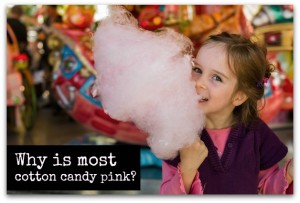Uncle John knows pretty much everything—and if he doesn’t, he heads his massive research library, or puts one of his many associates on the case. So go ahead: In the comments below, ask Uncle John anything. (And if we answer your question sometime, we’ll send you a free book!) This week’s question comes from reader James F., who asks…
Why is cotton candy most often colored pink?

It’s really quite a marvel of simple science. Simple sugar is exposed to heat, until it melts, then its pushed out of a tiny hole on a spinner through centrifugal force, making the candy long, stringy, grainy, and melt-in-your-mouthy. It’s so simple that it was invented all the way back in 1897 by Nashville candy maker John C. Wharton and William Morrison, ironically, a dentist. “Fairy floss” (it wouldn’t be called “cotton candy” in the U.S. until 1920) was popularized at the 1904 St. Louis World’s Fair, the same fair that introduced the world to ice cream cones and hot dogs.
Now you know everything you need to know about cotton candy, but why is it pink? It’s actually not because it was once called fairy floss (and still is called that, in Australia), and pink is a fairy-favorite color. It’s because colored cotton candy is more appetizing and fun than plain, white-colored cotton candy. Pink just happens to be the most popular color in terms of sales, so vendors tend to stick with that. Fun fact: They actually use red food coloring, but the process makes the final product come out pink.







